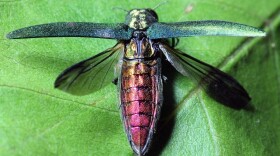It’s been a matter of ‘when’, not ‘if’: For years state officials have been expecting the destructive emerald ash borer to turn up in Vermont. Tuesday, the state announced it has found an infestation of the insect in part of the town of Orange.
Emerald ash borer has already infested forests in 31 other states, including those bordering Vermont and in the Province of Quebec. The result has been a widespread decline in ash species and the loss of hundreds of millions of trees in North America.
Ash accounts for 5 percent of Vermont’s forests and, in addition to its commercial value, it’s an important tree in urban areas. The Department of Forests, Parks and Recreation says a widespread infestation of the emerald ash borer, “could have significant ecological and economic impacts” in Vermont.
Barbara Schultz, forest health program manager with the department, says in coming days several state and federal agencies will conduct a delineation survey, visiting nearby areas to see if the infestation extends beyond the Orange area.

But Schultz says the insect is here to stay.
“What we won’t be able to do is eradicate this insect," Schultz says. "That hasn’t worked with emerald ash borer. We won’t be cutting all the trees down. That just has not been effective. It’s a case of slowing the spread. That’s our biggest priority.”
The insect was first discovered in 2002 in Michigan. State officials say it’s not clear how the emerald ash borer got to Orange, but it appears it has been there for a few years, before being spotted.
Left to its own devices the shiny green insect doesn’t cover much ground, and Schultz says it might spread one or two miles annually.
“What it does is it travels 65 mph down the interstate,” she says, referring to how the insect can be spread, for example, by transporting firewood from infested areas.
It’s currently illegal to transport firewood into Vermont from out of state, but Schultz says a federal quarantine that applies to infested areas will go into effect in Vermont once the state has learned the extent of the infestation and this will further restrict the movement of the wood.
In the past decade, the state has distributed thousands of bright purple traps designed to detect emerald ash borers, but it was a forest manager who spotted the tell-tale signs of the infestation in Orange and submitted an online report. Schultz says sharp-eyed Vermonters will be key to tracking the insect as it spreads through the state.

As for the near term, “There’s not a cause for a lot of optimism," says Schultz. "We will have a lot of dead trees.”
But she points out that work is being done with biocontrols like insects and parasites that attach the emerald ash borers, although it’s too early to say how effective these measures will be.
Schultz says about 1 percent of the Ash trees in infested areas survive.
“If we can retain enough Ash so that we have ash seedlings and saplings growing in our forests, ten years from now, 20 years from now, when these natural enemies may be established, that gives us a ray of hope.”
Copyright 2018 Vermont Public Radio







